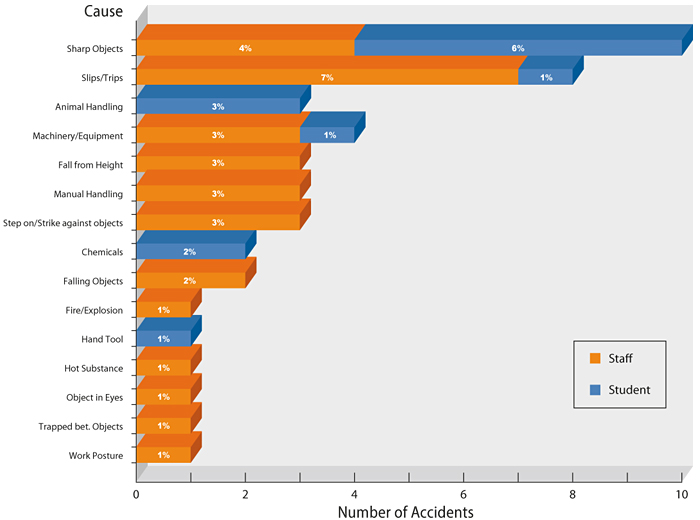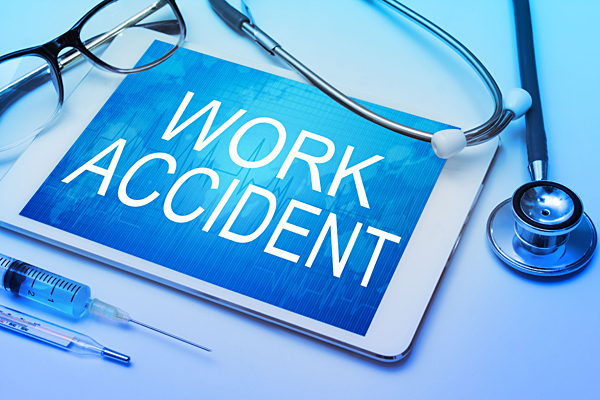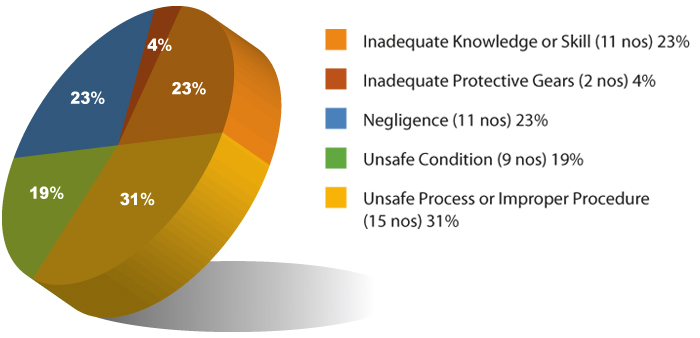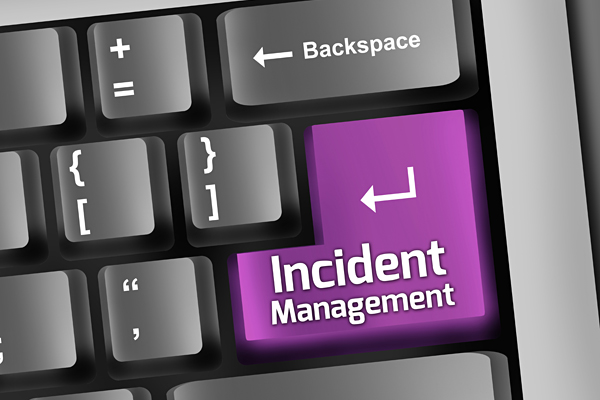Campus Health and Safety
Accident/Incident Statistics 2016
Number of Work/Study-Related Injuries
A total of 48 work/study-related injury cases were recorded in 2016. Among the cases:
-
30 cases involved staff members
-
14 cases involved students
-
4 cases involved contractors
A comparison of accident numbers over the past 10 years is shown in Table 1 below.
| Year | 2007 | 2008 | 2009 | 2010 | 2011 | 2012 | 2013 | 2014 | 2015 | 2016 |
|---|---|---|---|---|---|---|---|---|---|---|
| Staff Accident Number | 18 | 22 | 27 | 35 | 19 | 22 | 27 | 19 | 21 | 30 |
| Student Accident Number | 8 | 8 | 4 | 8 | 6 | 4 | 5 | 13 | 12 | 14 |
Lost Workdays
A total of 215 lost workdays of all the staff injury cases were recorded by the end of 2016. The comparison of lost workdays over the past 10 years is shown in Table 2 below.
The severity of individual cases is analysed and represented by the number of lost workdays as shown in Table 3. In all the 30 staff work-related injury cases, 8 cases did not incur any lost workdays, 11 cases incurred 3 or fewer lost workdays and 11 cases incurred more than 3 lost workdays. The largest number of lost workdays in one single case was 31 days.
| Year | 2007 | 2008 | 2009 | 2010 | 2011 | 2012 | 2013 | 2014 | 2015 | 2016 |
|---|---|---|---|---|---|---|---|---|---|---|
| Total number of Lost Workdays | 86 | 140 | 473 | 382 | 143.5 | 432 | 272 | 389 | 82.5 | 215 |
| Department | No. of Accidents | |||
|---|---|---|---|---|
| Total | LWD=0 | 0<LWD≤3 |
LWD>3 | |
| CEI | 1 | 1 | ||
| CBME | 1 | 1 | ||
| CHEM | 2 | 2 | ||
| CLE | 1 | 1 | ||
| DST | 1 | 1 | ||
| EVPPO | 2 | 1 | 1 | |
| FMO | 5 | 2 | 3 | |
| LANG | 1 | 1 | ||
| LIB | 1 | 1 | ||
| LIFS | 2 | 2 | ||
| SAO | 5 | 2 | 2 | 1 |
| SHRLO | 8 | 3 | 5 | |
| Total | 30 | 8 | 11 | 11 |
LWD = Lost Workday(s)
Causes of Work/Study-Related Injuries
Figure 1 summarizes the causes for all work/study-related injuries in 2016.
“Cuts by Sharp Objects” and “Slips/Trips” were the top causes for work/study-related injuries in 2016. Among the 10 cases caused by “sharp objects”, 2 cases were caused by broken glassware and 2 cases by needles. The 3 cases in “Animal Handling” were all “bites by mice”, and all involved students.

Locations of Accidents
Among all the injury cases (including contractors):
-
18 occurred in laboratories
-
7 occurred in student quarters
-
7 occurred in outdoor common areas
-
6 occurred in office areas
-
4 occurred in plant room/warehouse/workshop
-
3 occurred in indoor common areas
-
3 occurred in staff quarters

Common Root Causes of Accidents
Besides classifying causes of injuries in terms of physical sources and energies involved, investigation of the injury cases also revealed some common underlying root causes. These root causes are summarized in Figure 2 below.

Non-injury Incidents
A total of 9 non-injury work/study-related incidents were reported in 2016. Among the incidents, 8 occurred in laboratory areas and 1 occurred in outdoor common area. These incidents are summarized below by their nature:
- Chemical spill – 3 cases
- Strong smell from experiments causing evacuation and EV activation – 2 cases
- Flooding in laboratory – 1 case
- Improper treatment of suspected radioactive contamination – 1 case
- Unauthorized experiment in service corridor – 1 case
- Accidental damage of town gas pipe in maintenance operations – 1 case

Summary of Significant Findings

There were 44 cases of staff and students accidents in 2016, 11 cases more than that of the previous year. Among these additional 11 cases, there were 9 cases for staff accidents and 2 cases for student accidents.
- The number of lost workdays in 2016 was 215 days, a significant increase as compared with 82.5 days in the previous year.
- The major causes for injuries in 2016 were “cuts by sharp objects” and “slips and trips”, with 10 cases and 8 cases respectively.
- About 50% of all student accidents were attributed to “inadequate knowledge or skill” of the students, and 35 % were attributed to “unsafe work process or improper procedure”.
- Number of accidents occurred in laboratories remained as the highest (18 cases or 37.5%), including 13 student accidents (out of the total of 14 cases).
Common Root Causes of Accidents
- The number of accidents caused by “sharp objects” had significantly increased again last year (after a reduction from 8 cases in 2014 to 2 cases in 2015). Among the 10 cases last year, only 2 cases were caused by broken glassware (used to be the major cause under the “sharp objects” category). There were 2 injuries caused by using needles, one occurred during uncapping a needle, and the other occurred during recapping a contaminated needle. Proper procedures in handling needles should be emphasized and adequate training should be ensured.
- Although there was a reduction of “mouse-bite” injuries (from 5 cases to 3 cases), continuous efforts, including training and supervision, need to be maintained to further reduce or eliminate such injuries.
- Of the 3 “manual handling” injury cases, 2 of which occurred when colleagues were packing paper files and moving boxes in preparation for office relocation. Colleagues should be reminded of such risk in handling heavy objects in the office. Appropriate safety training materials are available in HSEO’s website. Assistance can also be sought from HSEO for providing appropriate safety training for concerned colleagues as necessary.
- Over 50% of accidents were attributed to “inadequate knowledge or skills” and “improper work procedures”. Appropriate risk assessments should be conducted for establishing proper work procedures. Adequate training and supervisions should be provided to ensure that proper work procedures are being followed.


